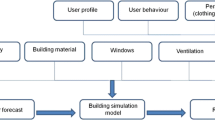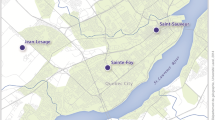Abstract
Humans spend most of their time in confined spaces and are hence primarily exposed to the direct influence of indoor climate. The Universal Thermal Climate Index (UTCI) was obtained in 31 rooms (eight buildings) in Berlin, Germany, during summer 2013 and 2014. The indoor UTCI was determined from measurements of both air temperature and relative humidity and from data of mean radiant temperature and air velocity, which were either measured or modeled. The associated outdoor UTCI was obtained through facade measurements of air temperature and relative humidity, simulation of mean radiant temperature, and wind data from a central weather station. The results show that all rooms experienced heat stress according to UTCI levels, especially during heat waves. Indoor UTCI varied up to 6.6 K within the city and up to 7 K within building. Heat stress either during day or at night occurred on 35 % of all days. By comparing the day and night thermal loads, we identified maximum values above the 32 °C threshold for strong heat stress during the nighttime. Outdoor UTCI based on facade measurements provided no better explanation of indoor UTCI variability than the central weather station. In contrast, we found a stronger relationship of outdoor air temperature and indoor air temperature. Building characteristics, such as the floor level or window area, influenced indoor heat stress ambiguously. We conclude that indoor heat stress is a major hazard, and more effort toward understanding the causes and creating effective countermeasures is needed.









Similar content being viewed by others
References
Almeida S, Casimiro E, Analitis A (2013) Short-term effects of summer temperatures on mortality in Portugal: a time-series analysis. J Toxic Environ Health A 76:422–428. doi:10.1080/15287394.2013.771550
Bedford T, Warner CG (1934) The globe thermometer in studies of heating and ventilation. Epidemiol Infect 34:458–473. doi:10.1017/S0022172400043242
Beizaee A, Lomas KJ, Firth SK (2013) National survey of summertime temperatures and overheating risk in English homes. Build Environ 65:1–17. doi:10.1016/j.buildenv.2013.03.011
Blazejczyk K, Epstein Y, Jendritzky G, Staiger H, Tinz B (2012) Comparison of UTCI to selected thermal indices. Int J Biometeorol 56:515–535. doi:10.1007/s00484-011-0453-2
Bröde P et al (2012) Deriving the operational procedure for the UTCI. Int J Biometeorol 56:481–494. doi:10.1007/s00484-011-0454-1
D'Ippoliti D et al (2010) The impact of heat waves on mortality in 9 European cities: results from the EuroHEAT project. Environ Heal 9:37
Fenner D, Meier F, Scherer D, Polze A (2014) Spatial and temporal air temperature variability in Berlin, Germany, during the years 2001–2010. Urban Climate 10(2):308–331. doi:10.1016/j.uclim.2014.02.004
Fiala D, Havenith G, Bröde P, Kampmann B, Jendritzky G (2012) UTCI-Fiala multi-node model of human heat transfer and temperature regulation. Int J Biometeorol 56:429–441. doi:10.1007/s00484-011-0424-7
Franck U, Krüger M, Schwarz N, Grossmann K, Röder S, Schlink U (2013) Heat stress in urban areas: Indoor and outdoor temperatures in different urban structure types and subjectively reported well-being during a heat wave in the city of Leipzig. Meteorol Z 22:167–177. doi:10.1127/0941-2948/2013/0384
Gabriel KMA, Endlicher WR (2011) Urban and rural mortality rates during heat waves in Berlin and Brandenburg, Germany. Environ Pollut 159:2044–2050. doi:10.1016/j.envpol.2011.01.016
Havenith G et al (2012) The UTCI-clothing model. Int J Biometeorol 56:461–470. doi:10.1007/s00484-011-0451-4
Höppe PR (1993) Indoor climate. Experientia 49:775–779. doi:10.1007/BF01923547
Jendritzky G, de Dear R, Havenith G (2012) UTCI—why another thermal index? Int J Biometeorol 56:421–428. doi:10.1007/s00484-011-0513-7
Kántor N, Unger J (2011) The most problematic variable in the course of human-biometeorological comfort assessment—the mean radiant temperature. Cent Eur J Geosci 3:90–100. doi:10.2478/s13533-011-0010-x
Kjellstrom T, McMichael AJ (2013) Climate change threats to population health and well-being: the imperative of protective solutions that will last. Global Health Action 6:20816. doi:10.3402/gha.v6i0.20816
Konarska J, Lindberg F, Larsson A, Thorsson S, Holmer B (2014) Transmissivity of solar radiation through crowns of single urban trees-application for outdoor thermal comfort modelling. Theor Appl Climatol 117:363–376. doi:10.1007/s00704-013-1000-3
Koppe C (2009) Das Hitzewarnsystem des Deutschen Wetterdienstes/The heat health warning system of the German Meteorological Service Umwelt-Medizinischer Informations-Dienst-Klimawandel und Gesundheit 3:39–43
Kuehn LA, Stubbs RA, Weaver RS (1970) Theory of the globe thermometer. J Appl Physiol 29:750–757
La Gennusa M, Nucara A, Rizzo G, Scaccianoce G (2005) The calculation of the mean radiant temperature of a subject exposed to the solar radiation—a generalised algorithm. Build Environ 40:367–375. doi:10.1016/j.buildenv.2004.06.019
Langner M, Scherber K, Endlicher W (2013) Indoor heat stress: an assessment of human bioclimate using the UTCI in different buildings in berlin. Erde 144:260–273
Lindberg F, Holmer B, Thorsson S (2008) SOLWEIG 1.0—modelling spatial variations of 3D radiant fluxes and mean radiant temperature in complex urban settings. Int J Biometeorol 52:697–713. doi:10.1007/s00484-008-0162-7
Lundgren K, Kuklane K, Gao CS, Holmer I (2013) Effects of heat stress on working populations when facing climate change. Ind Health 51:3–15
Matzarakis A, Endler C (2010) Climate change and thermal bioclimate in cities: impacts and options for adaptation in Freiburg, Germany. Int J Biometeorol 54:479–483. doi:10.1007/s00484-009-0296-2
Matzarakis A, Rutz F, Mayer H (2007) Modelling radiation fluxes in simple and complex environments - application of the RayMan model. Int J Biometeorol 51:323–334. doi:10.1007/s00484-006-0061-8
Matzarakis A, Rutz F, Mayer H (2010) Modelling radiation fluxes in simple and complex environments: basics of the RayMan model. Int J Biometeorol 54:131–139. doi:10.1007/s00484-009-0261-0
McGeehin MA, Mirabelli M (2001) The potential impacts of climate variability and change on temperature-related morbidity and mortality in the United States. Environ Health Perspect 109(Suppl 2):185–189
McMichael AJ, Haines A (1997) Global climate change: the potential effects on health. BMJ 315:805–809
Melikov AK, Skwarczynski MA, Kaczmarczyk J, Zabecky J (2013) Use of personalized ventilation for improving health, comfort, and performance at high room temperature and humidity. Indoor Air 23:250–263. doi:10.1111/ina.12012
Michelozzi P, Accetta G, De Sario M (2009) High temperature and hospitalizations for cardiovascular and respiratory causes in 12 European cities. Am J Respir Crit Care Med 179:383–389
Mirzaei PA, Haghighat F, Nakhaie AA, Yagouti A, Giguere M, Keusseyan R, Coman A (2012) Indoor thermal condition in urban heat island—development of a predictive tool. Build Environ 57:7–17. doi:10.1016/j.buildenv.2012.03.018
Monteiro A, Carvalho V, Oliveira T, Sousa C (2013) Excess mortality and morbidity during the July 2006 heat wave in Porto, Portugal. Int J Biometeorol 57:155–167. doi:10.1007/s00484-012-0543-9
Nguyen JL, Schwartz J, Dockery DW (2014) The relationship between indoor and outdoor temperature, apparent temperature, relative humidity, and absolute humidity. Indoor Air 24:103–112. doi:10.1111/ina.12052
Parson KC (2003) Human thermal environments: the effects of hot, moderate and cold environments on human health, comfort and performance. New York, London
Pfafferott J, Becker P (2008) Erweiterung des Hitzewarnsystems um die Vorhersage der Wärmebelastung in Innenräumen (Extension of the Heat Health Warning System by Indoor Heat Prediction). Bauphysik 30:237–243. doi:10.1002/bapi.200810031
Quinn A, Tamerius JD, Perzanowski M, Jacobson JS, Goldstein I, Acosta L, Shaman J (2014) Predicting indoor heat exposure risk during extreme heat events. Sci Total Environ 490:686–693. doi:10.1016/j.scitotenv.2014.05.039
RCoreTeam (2012) R: A language and environment for statistical computing. Vienna, Austria
Scherber K, Langner M, Endlicher W (2013) Spatial analysis of hospital admissions for respiratory diseases during summer months in Berlin taking bioclimatic and socio-economic aspects into account. Erde 144:217–237
Schulze J (2004) Sehr unterschiedliche Dämmwirkung an Altbauten/Different effectiveness of insulation in old buildings. Bauhandwerk
Smoyer KE, Rainham DGC, Hewko JN (2000) Heat-stress-related mortality in five cities in Southern Ontario: 1980–1996. Int J Biometeorol 44:190–197. doi:10.1007/s004840000070
Walikewitz N, Jänicke B, Langner M, Meier F, Endlicher W (2015) The difference between the mean radiant temperature and the air temperature within indoor environments: a case study during summer conditions. Build Environ 84:151–161. doi:10.1016/j.buildenv.2014.11.004
Witterseh T, Wyon DP, Clausen G (2004) The effects of moderate heat stress and open-plan office noise distraction on SBS symptoms and on the performance of office work. Indoor Air 14:30–40. doi:10.1111/j.1600-0668.2004.00305.x
Ye X, Wolff R, Yu W, Vaneckova P, Pan X, Tong S (2012) Ambient temperature and morbidity: a review of epidemiological evidence. Environ Health Perspect 120:19–28. doi:10.1289/ehp.1003198
Acknowledgments
We would like to thank the German research foundation (DFG) for funding Research Unit 1736 “Urban Climate and Heat stress in mid-latitude cities in view of climate change (UCaHS)” (EN138/21-1, SCHE 750/8-1 and SCHE 750/9-1) and Phillip Schuster for his support with data collection.
Author information
Authors and Affiliations
Corresponding author
Rights and permissions
About this article
Cite this article
Walikewitz, N., Jänicke, B., Langner, M. et al. Assessment of indoor heat stress variability in summer and during heat warnings: a case study using the UTCI in Berlin, Germany. Int J Biometeorol 62, 29–42 (2018). https://doi.org/10.1007/s00484-015-1066-y
Received:
Revised:
Accepted:
Published:
Issue Date:
DOI: https://doi.org/10.1007/s00484-015-1066-y




